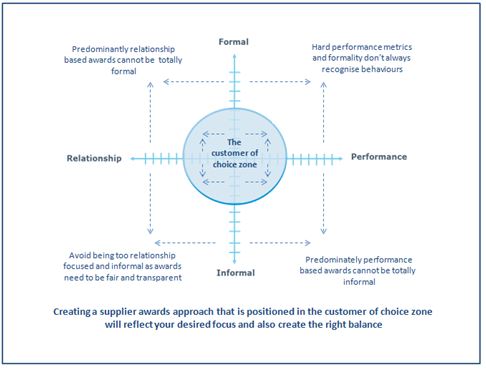
Just rewards
Are you rewarding acts of bravery or performance?
So you’re thinking about how you could introduce a supplier recognition or awards programme. This three part blog looks at what questions you should ask before setting up a supplier awards programme.
Firstly why, and what you think it will achieve? Secondly, how to go about it? How you measure suppliers? And finally, what it might look like and how to run a supplier awards event?
In this part one explores why you are considering the creation of a supplier awards programme and what you’re hoping it will achieve? For example, are you trying to do?
-
Create supplier loyalty,
-
Optimise supplier performance,
-
Reward going the extra mile during a crisis or new product development/launch,
-
Improve your standing as a customer of choice,
-
Get suppliers working more collaboratively with you,

-
Incentivise suppliers to work more pro-actively on your behalf,
-
Recognise excellence in a focus area (quality/delivery/CSR etc.),
-
Reward supplier innovation and gain more access to it, or
All or some combination of the above points.
What you are trying to achieve will shape the nature and the formality of your supplier awards programme, including what measurements ensure you can correctly recognise the supplier’s efforts. We’ve created a continuum which on the x-axis looks at what is more important to you, relationship versus performance and how formal or informal you wish to make the awards.

Top right quadrant where the focus is on performance and very formal. The focus needs to be on supplier measurement of KPI’s and SLA’s, ‘hard’ measures of performance that are used to create a league table of supplier results and the ‘best’ suppliers are rewarded. However, hard performance metrics and formality don’t always recognise behaviours. It’s possible that stakeholders will not always enjoy and value working with suppliers that score well in this area.
The bottom left is where the focus is on the relationship and more informal recognition, where awards are based on perceived value that is added. Typically this will be ‘acts of bravery’ or activities like pro-active collaboration, commitment and ‘going the extra mile’, responsiveness and flexibility. However, it’s important that awards are fair and transparent and that awards are not too subjective. Recognising suppliers in this way can lead to stakeholders (and even suppliers) challenging the legitimacy of awards that don’t recognise performance as a fundamental.
The further extremes of the top left and bottom right quadrants reflect a predominantly relationship based approach that is very formal and a predominantly performance based approach that is very informal. Neither of these are practical or desirable and should be avoided.
Creating a supplier awards approach that is positioned in the customer of choice zone will reflect your desired focus and also create the right balance.
So what will supplier awards based on performance achieve? It could be argued that suppliers are contractually obliged to meet all of their SLAs and KPIs and the agreed remuneration for the provision of products or services should be enough of an incentive. However, we know in reality that SLAs and KPIs are not always achieved.
This can be for numerous reasons but one might be that the supplier will on occasion have internal or external challenges that result in them needing to make choices and prioritise across their customer base. It’s under these circumstances that performance-based supplier recognition beyond contractual remuneration can influence that prioritisation. In addition, performance-based recognition is likely to increase the focus that your supplier senior executives have on performance. In summary, if optimised supplier performance is your priority, then a performance based supplier recognition programme can only help.
Alternatively, awards and recognition based on the supplier’s contribution to the relationship is more likely to result in behavioural change and have a broader impact on the relationship. These changed behaviours can lead to increased commitment, flexibility, collaboration, access to innovation, access to and retention of the supplier’s best people. Those are in short many of the benefits of being a customer of choice.
Our advice is to measure both performance and relationship and we look at how you design this to support becoming a customer of choice in part two of this blog. However, don’t think that becoming a customer of choice is just about having a supplier awards programme. It will help, but customer of choice status will only be achieved if an organisation is prepared to change its behaviours.
It’s important to be clear about what you are trying to achieve from your supplier awards programme and therefore how you go about designing it and what you need to measure.
Next time, in part 2, we’ll look at how you go about designing and setting up a supplier awards programme.